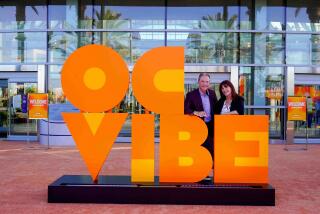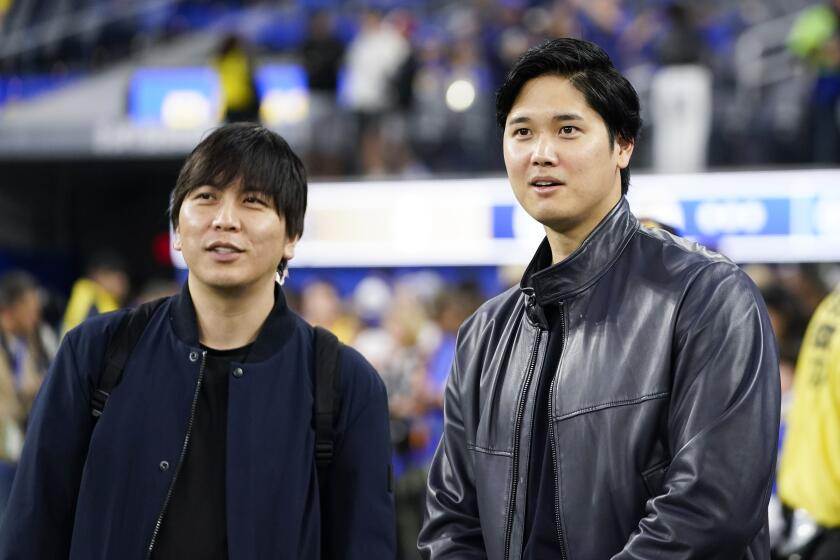‘L.A. Live on steroids:’ Inside Anaheim’s pitch to keep the Angels
For more than half a century, the Angels have played at Angel Stadium, a ballpark surrounded by an enormous parking lot. It is a very Southern California experience: drive to game, see game, drive home.
That experience is slowly changing. Golden Road Brewery opened a restaurant and patio last year across the street from the ballpark, a place to go before or after the game. The words painted on one wall, high above a row of taps: “BREWED & CANNED IN LA.”
With the Angels and the city of Anaheim poised to renew negotiations intended to keep the baseball team in town for decades to come, the success of the talks could turn on one question: Does the team buy into the city’s latest vision to build up the area around the ballpark?
It is not a vision of another brewpub down the street — already there — or an apartment complex 900 feet from home plate — also already there.
It is a vision brewed in L.A., a concept that Anaheim would like to export and expand, an entertainment district that would light up the skies and attract millions each year to eat and drink, shop and play, and work and live within steps of Angel Stadium and the nearby Honda Center, home to the NHL’s Ducks.
“We really think it can be L.A. Live on steroids,” said John Woodhead, the city’s director of community and economic development.
Angel Stadium, which opened in 1966, is the fourth-oldest stadium in the major leagues. Six years ago, the city and team cooperated on a study that showed the stadium needed about $150 million in upgrades to remain a viable long-term venue. Anaheim, like most California cities, has realized that it makes little economic sense to spend tax dollars on sports facilities if team owners keep almost all of the revenue.
The city pitched the Angels on this plan: Put up restaurants and shops in the stadium parking lot, and maybe a hotel too. Make lots of money. Use some to pay for the stadium upgrades and keep the rest.
That plan collapsed, and the city since has approved another development, a few steps from the parking lot, on behalf of real estate developer LT Global. In a 2016 letter, the Angels had implored the city’s planning commission to reject the LT Global proposal.
“Approving the LT project would, as a practical matter, eliminate the possibility that a sports-entertainment-hotel center could be developed at Angel Stadium,” Angels attorney Allan J. Abshez wrote. “Such a decision … would fundamentally undermine the Angels negotiations to remain in Anaheim over the long term and create a revenue stream to fund the much-needed capital needs of the stadium.”
The LT project calls for 200 hotel rooms, 340 residences and 21 alcohol licenses for on-site restaurants and brewpubs open to the public. So the Angels might not generate windfall profits by putting up a second hotel, not far from the one from LT, and sports bars in the shadow of all those taps.
The city, though, has wooed the team on playing a leading role in a much grander production.
The new pitch: Think not of a couple of new buildings in the corner of a parking lot, but of a sports and entertainment district that spans both sides of the Orange Freeway, awash in light and sound, anchored by Angel Stadium, the Honda Center, the LT project and the train station intended to serve as the city’s transportation hub.
“We have the opportunity to introduce spectaculars,” Woodhead said. “One of the inspiration palettes we shared with the Angels depicted a bright entertainment neighborhood, with all sorts of digital displays, and all sorts of entertainment opportunities and venues.”
Two months ago, the Ducks’ owners agreed to buy the city land surrounding the Honda Center and develop it in concert with the train station across the street.
Michael Schulman, the Ducks’ chief executive officer, said he has talked with the Angels about compatible development inspired by L.A. Live, and by the entertainment village surrounding the new Rams and Chargers stadium in Inglewood.
“I think this whole area is going to become as vibrant a place to come as any in Orange County,” Schulman said. “I think we’re going to do it right. I think the Angels will do it right, and I hope they stay.”
At first glance, the L.A. Live comparison appears flawed. That complex — anchored by Staples Center and the Microsoft Theater, and with the Los Angeles Convention Center within walking distance — attracts 20 million visitors each year, spokesman Michael Roth said.
At its would-be rival in Anaheim, events at Angel Stadium, Honda Center and the Grove theater adjacent to the Angel Stadium parking lot combine to attract an estimated 5 million visitors per year.
Sign up for our daily sports newsletter »
However, the L.A. Live district covers 23 acres. The proposed sports and entertainment district in Anaheim spans 231 acres.
“You simply don’t have any development opportunities like this in Southern California,” Woodhead said.
The Dodger Stadium property covers close to 300 acres and it is anticipated that the Dodgers’ owners eventually will pursue development there, particularly if a proposed gondola from Union Station can link the hilltop site to downtown. However, the planning and zoning battles could take years.
In Anaheim, the planning and zoning process is long over, the construction well underway. The so-called “Platinum Triangle” area — the larger neighborhood, with Angel Stadium at the heart of its 820 acres — has attracted more than $1.5 billion in investments toward what city planners call an “urban village.”
The Angels plan to conduct their own market studies before engaging in negotiations with the city. They are intrigued for now.
“Given the city’s robust vision for the Platinum Triangle, and the presence of the stadium, there is the possibility of significant potential for the surrounding properties,” Angels spokeswoman Marie Garvey said in a statement.
Over the decades, the city has been long on glamorous development plans for the Angel Stadium property, but short on success.
After the Rams left Anaheim for St. Louis in 1995, the city pitched the NFL on buying a piece of the Angel Stadium parking lot, and building an interactive football theme park adjacent to a new NFL stadium. The NFL passed.
In 1996, the city proposed a 159-acre “Sportstown” that would have included hotels, shops and offices as well as orchards, a produce market, youth sports fields and a Western village with a rodeo arena. There was a plan to connect Angel Stadium to what is now Honda Center. The Walt Disney Co. bought the Angels that year, and the city asked Disney to develop the project. Disney passed, and an outside developer failed to generate interest among potential tenants.
The key to success now might be the residential component of the Platinum Triangle, and the assurance that an entertainment district could be vibrant and economically viable on days the Angels and Ducks do not play.
In 2004, when the city approved the Platinum Triangle, the plan called for 28,000 residents. Since then, the area has attracted 5,000, although five residential projects are under construction.
“It’s still a business center with rooftops,” said Louis Tomaselli, the Irvine-based senior managing director of JLL, a real estate and investment management firm. “After lunch, it’s still a difficult time for retailers. It just hasn’t turned out to be a dense residential area yet.
“Everybody wants the big, gleaming, high-profile project. There has to be the support and the mass behind it. At the end of the day, the developer — the Angels or whoever — has to make money. Otherwise, it makes no sense.”
Amid all the visions of dining and drinking, movies and live shows, and baseball and hockey, there is a missing component that could help Angels owner Arte Moreno win the hearts and dollars of the growing number of residents. The component would not make Moreno enough money by itself to justify financing a major development, a city official said, but it would fill a community need among all the glitz and glamour.
And what would that missing component be?
“A Trader Joe’s,” the city official said.
Follow Bill Shaikin on Twitter @BillShaikin
More to Read
Go beyond the scoreboard
Get the latest on L.A.'s teams in the daily Sports Report newsletter.
You may occasionally receive promotional content from the Los Angeles Times.







